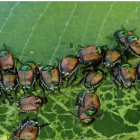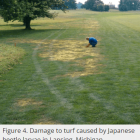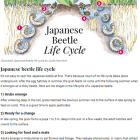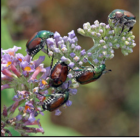Japanese Beetle
Posted on Aug 20, 2024 in NewsJAPANESE BEETLE (POPILLIIA JAPONICA)
- Regulatory Status: The United States Department of Agriculture, Animal & Plant Health Inspection Service maintains the Japanese Beetle Quarantine and Regulations to protect agriculture and prevent the human-assisted spread of this pest. The Federal quarantine is designed to reduce artificial spread of Japanese beetles by aircraft.
- What You Can Do to address Japanese Beetle {Japanese Beetle is Not Found in Hawaii, but its a constant threat) See Below}
- Report this species if seen on any island! Japanese Beetle is not present in Hawaii, but the State is in constant threat through ports, harbors, and plant soils from infected areas.
- Intervention Status: Eradication all Islands
Photo:GoBigRed https://grobigred.com/
{Click Tabs} DESCRIPTIONIMPACTSERADICATION & CONTROL METHODSWHAT YOU CAN DOo Japanese beetles are found in a variety of habitats, including gardens, grasslands, forests, and urban spaces, residential lawns, golf courses, sports fields, and parks. o Adults are about 1cm. in length and are about the size of a penny. Anything larger is most likely another insect.
o The bodies of adult beetles are green, however their wing coverings are copper-brown, and they have five distinctive bright white tufts of hair along each backside of their lower abdomen
o Their eggs are roundish and can appear white, creamy, or even translucent in color.
o Larvae are C-shaped, about 2.5cm. in length with a creamy white body, yellowish-brown head, and can be distinguished from other species of larvae based on their V-shaped spine• o The beetle does well in areas with moderate temperatures and precipitation. Japanese Beetle adults live up to 45 days and are active during the summer months where the females will lay about 50 eggs in their lifetime. Larva stay in the soil from fall until they emerge in early summer.
o Japanese beetle grubs feed below ground on the roots of turf and ornamental plants. Patches of dead turf can be an indicator of Japanese Beetle grubs damage.
o The Beetles can defoliate plants. Continued feeding can reduce a plant’s ability to take up enough water and nutrients. This damage causes plants to be more susceptible to disease and stress, have higher death rates, and lose the ability to photosynthesize.
o Japanese Beetles are one of the most significant turf-grass pests that cost an estimated $460M per year to control. The Oregon Invasive Species Committee estimates that if Japanese Beetles become established in Oregon, the economic impact to all crops, commodities, and other related businesses could be over $34M.
o Adults tend to congregate together in large groups when feeding and are rarely seen alone. When feeding, these beetles skeletonize the foliage by feeding between the veins of the leaf, creating a distinctive lace-like pattern.
o They tend to gather and feed on plant material growing directly in the sun, beginning at the top of the plant and moving downward.
o They feed on many different ornamental and agricultural plants, flowers, fruits, and trees, such as: elm, maple, black walnut, fruit trees (e.g., cherry, plum, apple, apricot, peach, etc.), soybean, asparagus, corn, tomato, blueberries, blackberries, and grapes. Additional preferred plants and hosts include rose, linden, crabapple, and related trees, birch, raspberry, currant, basil, Virginia creeper, hollyhock, marigold, Norway and Japanese maple, birch, purple-leaf plum, mountain ash, and basil.
o Larvicides such as Acelepryn (with active ingredient chlorantraniliprole) target root eating larvae and are not harmful to people or wildlife;
Ground applications are applied once per year by trained and licensed applicators
o Biological Control: Two natural enemies of Japanese beetles have been released in Minnesota. The fly Istocheta aldrichi lays eggs on adult Japanese beetles in summer, whereas the wasp Tiphia vernalis parasitizes grubs in the spring.
Although both natural enemies became established, neither is very abundant and have little impact on Japanese Beetle populations.
o The Ports-of-Entry Monitoring Program (HISC/CGAPS/ISCs) has set up traps at all harbor and airport points-of-entry in Hawaii o Pathogenic nematode Over-the-Counter products are available and can be applied late summer or early fall;
o Do not transporting the adults or grubs in plants or soil
o Report to 643-Pest and 643Pest.org if found anywhere in Hawaii
o Monitor the health of plants and crops regularly for any signs or symptoms;
o Shaking the branches of infested plants can dislodge beetles easily
o Cover plants with cheesecloth or other fine netting materials :
o When landscaping, choose plants that are less favored by Japanese beetles, such as:
Arborvitae, black gum, begonias, boxwood, clematis, dogwoods, firs, forsythia, fringetree, hemlock, hickory, holly, hostas, ironwood, junipers, lilac, magnolia, musclewood, northern red oak, pines, red maple, silver linden, spruces, sweet gum, tulip tree, white oak, yellowwood and yews.
DESCRIPTIONIMPACTSERADICATION & CONTROL METHODSWHAT YOU CAN DO
o Japanese beetles are found in a variety of habitats, including gardens, grasslands, forests, and urban spaces, residential lawns, golf courses, sports fields, and parks. o Adults are about 1cm. in length and are about the size of a penny. Anything larger is most likely another insect.
o The bodies of adult beetles are green, however their wing coverings are copper-brown, and they have five distinctive bright white tufts of hair along each backside of their lower abdomen
o Their eggs are roundish and can appear white, creamy, or even translucent in color.
o Larvae are C-shaped, about 2.5cm. in length with a creamy white body, yellowish-brown head, and can be distinguished from other species of larvae based on their V-shaped spine• o The beetle does well in areas with moderate temperatures and precipitation. Japanese Beetle adults live up to 45 days and are active during the summer months where the females will lay about 50 eggs in their lifetime. Larva stay in the soil from fall until they emerge in early summer.
o The bodies of adult beetles are green, however their wing coverings are copper-brown, and they have five distinctive bright white tufts of hair along each backside of their lower abdomen
o Their eggs are roundish and can appear white, creamy, or even translucent in color.
o Larvae are C-shaped, about 2.5cm. in length with a creamy white body, yellowish-brown head, and can be distinguished from other species of larvae based on their V-shaped spine• o The beetle does well in areas with moderate temperatures and precipitation. Japanese Beetle adults live up to 45 days and are active during the summer months where the females will lay about 50 eggs in their lifetime. Larva stay in the soil from fall until they emerge in early summer.
o Japanese beetle grubs feed below ground on the roots of turf and ornamental plants. Patches of dead turf can be an indicator of Japanese Beetle grubs damage.
o The Beetles can defoliate plants. Continued feeding can reduce a plant’s ability to take up enough water and nutrients. This damage causes plants to be more susceptible to disease and stress, have higher death rates, and lose the ability to photosynthesize.
o Japanese Beetles are one of the most significant turf-grass pests that cost an estimated $460M per year to control. The Oregon Invasive Species Committee estimates that if Japanese Beetles become established in Oregon, the economic impact to all crops, commodities, and other related businesses could be over $34M.
o Adults tend to congregate together in large groups when feeding and are rarely seen alone. When feeding, these beetles skeletonize the foliage by feeding between the veins of the leaf, creating a distinctive lace-like pattern.
o They tend to gather and feed on plant material growing directly in the sun, beginning at the top of the plant and moving downward.
o They feed on many different ornamental and agricultural plants, flowers, fruits, and trees, such as: elm, maple, black walnut, fruit trees (e.g., cherry, plum, apple, apricot, peach, etc.), soybean, asparagus, corn, tomato, blueberries, blackberries, and grapes. Additional preferred plants and hosts include rose, linden, crabapple, and related trees, birch, raspberry, currant, basil, Virginia creeper, hollyhock, marigold, Norway and Japanese maple, birch, purple-leaf plum, mountain ash, and basil.
o The Beetles can defoliate plants. Continued feeding can reduce a plant’s ability to take up enough water and nutrients. This damage causes plants to be more susceptible to disease and stress, have higher death rates, and lose the ability to photosynthesize.
o Japanese Beetles are one of the most significant turf-grass pests that cost an estimated $460M per year to control. The Oregon Invasive Species Committee estimates that if Japanese Beetles become established in Oregon, the economic impact to all crops, commodities, and other related businesses could be over $34M.
o Adults tend to congregate together in large groups when feeding and are rarely seen alone. When feeding, these beetles skeletonize the foliage by feeding between the veins of the leaf, creating a distinctive lace-like pattern.
o They tend to gather and feed on plant material growing directly in the sun, beginning at the top of the plant and moving downward.
o They feed on many different ornamental and agricultural plants, flowers, fruits, and trees, such as: elm, maple, black walnut, fruit trees (e.g., cherry, plum, apple, apricot, peach, etc.), soybean, asparagus, corn, tomato, blueberries, blackberries, and grapes. Additional preferred plants and hosts include rose, linden, crabapple, and related trees, birch, raspberry, currant, basil, Virginia creeper, hollyhock, marigold, Norway and Japanese maple, birch, purple-leaf plum, mountain ash, and basil.
o Larvicides such as Acelepryn (with active ingredient chlorantraniliprole) target root eating larvae and are not harmful to people or wildlife;
Ground applications are applied once per year by trained and licensed applicators
o Biological Control: Two natural enemies of Japanese beetles have been released in Minnesota. The fly Istocheta aldrichi lays eggs on adult Japanese beetles in summer, whereas the wasp Tiphia vernalis parasitizes grubs in the spring.
Although both natural enemies became established, neither is very abundant and have little impact on Japanese Beetle populations.
o The Ports-of-Entry Monitoring Program (HISC/CGAPS/ISCs) has set up traps at all harbor and airport points-of-entry in Hawaii o Pathogenic nematode Over-the-Counter products are available and can be applied late summer or early fall;
Ground applications are applied once per year by trained and licensed applicators
o Biological Control: Two natural enemies of Japanese beetles have been released in Minnesota. The fly Istocheta aldrichi lays eggs on adult Japanese beetles in summer, whereas the wasp Tiphia vernalis parasitizes grubs in the spring.
Although both natural enemies became established, neither is very abundant and have little impact on Japanese Beetle populations.
o The Ports-of-Entry Monitoring Program (HISC/CGAPS/ISCs) has set up traps at all harbor and airport points-of-entry in Hawaii o Pathogenic nematode Over-the-Counter products are available and can be applied late summer or early fall;
o Do not transporting the adults or grubs in plants or soil
o Report to 643-Pest and 643Pest.org if found anywhere in Hawaii
o Monitor the health of plants and crops regularly for any signs or symptoms;
o Shaking the branches of infested plants can dislodge beetles easily
o Cover plants with cheesecloth or other fine netting materials :
o When landscaping, choose plants that are less favored by Japanese beetles, such as:
Arborvitae, black gum, begonias, boxwood, clematis, dogwoods, firs, forsythia, fringetree, hemlock, hickory, holly, hostas, ironwood, junipers, lilac, magnolia, musclewood, northern red oak, pines, red maple, silver linden, spruces, sweet gum, tulip tree, white oak, yellowwood and yews.
o Report to 643-Pest and 643Pest.org if found anywhere in Hawaii
o Monitor the health of plants and crops regularly for any signs or symptoms;
o Shaking the branches of infested plants can dislodge beetles easily
o Cover plants with cheesecloth or other fine netting materials :
o When landscaping, choose plants that are less favored by Japanese beetles, such as:
Arborvitae, black gum, begonias, boxwood, clematis, dogwoods, firs, forsythia, fringetree, hemlock, hickory, holly, hostas, ironwood, junipers, lilac, magnolia, musclewood, northern red oak, pines, red maple, silver linden, spruces, sweet gum, tulip tree, white oak, yellowwood and yews.
For more information
- Japanese Beetle is a target species of the Ports of Entry Monitoring (PoEM) program
- Japanese Beetle generally do not feed on or damage the following: boxwood, clematis, chrysanthemum, conifers (e.g. arborvitae, spruce, fir, pine), daylily, geranium, ginkgo, Japanese tree lilac, forsythia, common lilac, magnolia, red and silver maple, oak, white poplar, redbud, rhododendron and yew
- Background, Lifecyle Pamphlet (Oregon Dept of Agriculture)
- There are no known threats to people or animals from Japanese Beetle
- Japanese Beetle may be undergoing a name change in the near future
- 2019 Webinar Oregon Department of Agriculture
- Pending Legislation: None
- Look A-Likes Document








